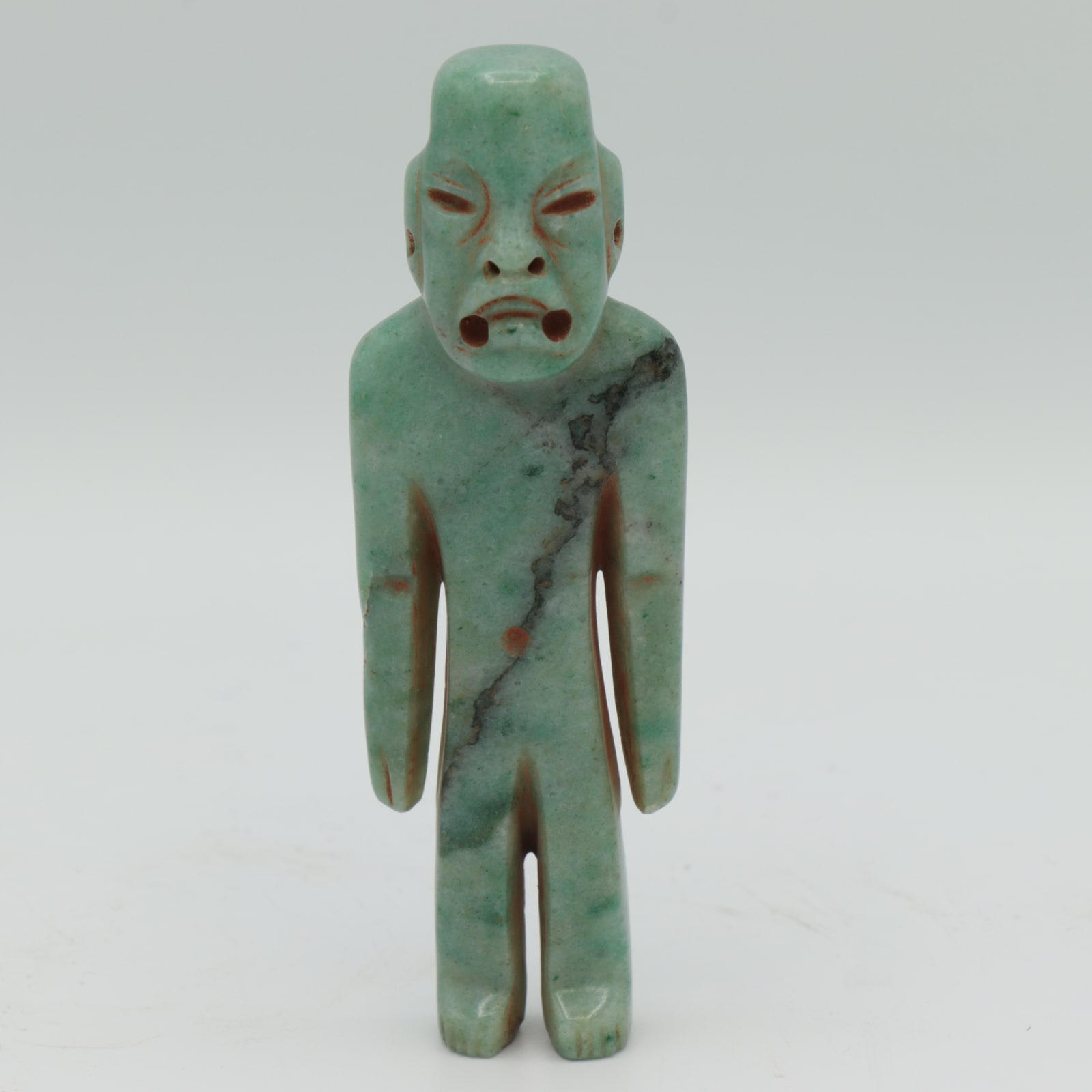Olmec Figure, c.900-700 BCE
Jade
height 9.8 cm
height 3 7/8 in
height 3 7/8 in
EL.0068
This standing figure is made of jade, a material that was highly valued for its colour and translucent appearance. The fact that the only source in ancient Mesoamerica was the...
This standing figure is made of jade, a material that was highly valued for its colour and translucent appearance. The fact that the only source in ancient Mesoamerica was the Motagua River valley, in eastern Guatemala, and therefore it would have been necessary to transport it a considerable distance in order to use it for Olmec objects, would have added to the prestige of artworks made from this material. The body is characterised by long arms but short legs, and a narrow torso, giving it a slightly inhuman appearance. Carved lines mark out the fingers, toes, and elbows. There is no neck, but instead the long head is set directly onto the thick shoulders. The eyes are narrow, with diagonal brows and semi-circular lines around the inside, giving the figure a fierce expression. The large, fleshy lips are downturned. The frowning expression and oversized downturned mouth are facial characteristics which appear often in Olmec art, and have gained an association with a theorised supernatural entity known as a ‘were-jaguar’. As one of the primary predators in Mesoamerica, the jaguar would have been respected as well as feared in Olmec culture. In the mid-20th century, a theory arose that the were-jaguar motif originated from a mythical story of copulation between a jaguar and a human woman; this theory was based on some fragmentary monuments which could be interpreted as representations of this event. However, it is not universally agreed that this is what the monuments depict, and some scholars think that we ought to question whether the motif is even actually related to the jaguar; other explanations have been put forth for the combination of facial features, such as genetic abnormalities or a connection with a native species of toad. Whatever the original significance of the motif, this sculpture is a beautiful example of how it was used within Olmec artwork. A natural dark vein in the stone forms a diagonal line across the torso of the figure. Circles mark the belly button, nostrils, and the corners of the mouth, and holes are pierced through the earlobes. This would have allowed it to be suspended and perhaps worn by the owner.
The Olmec civilisation was one of the earliest civilisations in Mesoamerica, lasting from around 1600 to 400 BCE, and it was based in the modern-day Mexican states of Veracruz and Tabasco, on the coast of the Gulf of Mexico. They are thought to have invented several Mesoamerican traditions such as bloodletting and the Mesoamerican ballgame, as well as possibly the Mesoamerican calendar, zero, and popcorn. Their first important centre was in San Lorenzo Tenochtitlán, and after that it appears to have moved to La Venta. The region provided many advantages for a burgeoning civilisation, such as alluvial soil which can be highly fertile, and access to the Coatzacoalcos River basin, which offered opportunities for transportation. The dense population which formed in this area is thought to have led to the rise of an elite group, creating demand for luxury items made of high-value materials which came to characterise Olmec culture.
The Olmec civilisation was one of the earliest civilisations in Mesoamerica, lasting from around 1600 to 400 BCE, and it was based in the modern-day Mexican states of Veracruz and Tabasco, on the coast of the Gulf of Mexico. They are thought to have invented several Mesoamerican traditions such as bloodletting and the Mesoamerican ballgame, as well as possibly the Mesoamerican calendar, zero, and popcorn. Their first important centre was in San Lorenzo Tenochtitlán, and after that it appears to have moved to La Venta. The region provided many advantages for a burgeoning civilisation, such as alluvial soil which can be highly fertile, and access to the Coatzacoalcos River basin, which offered opportunities for transportation. The dense population which formed in this area is thought to have led to the rise of an elite group, creating demand for luxury items made of high-value materials which came to characterise Olmec culture.
